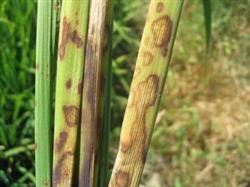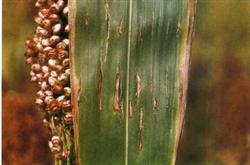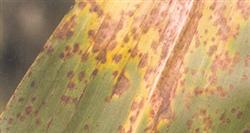Sorghum sheath blight

The symptom of the disease is common in the north and Taiwan, the hybrid sorghum is more serious, and it also occurs in central and southwest China. It is mainly harmful to leaf sheath and can also be harmful to leaves. After the disease, water-immersed lesions first appeared on the stem near the ground, and then purplish red and gray spots appeared on the later leaf sheath. In the late growth period or under rainy and humid weather, brown sclerotia appeared in the diseased part. The disease can also spread to the top of the plant, causing damage to leaves. The seriously diseased plants died early. The leaf sheath at the base of the stem was infected with a small white-green water-immersed spot, and then expanded into an oval, brown around and lighter spot in the middle. The infected leaves showed gray-green to gray-white cloud spots, and most of the disease spots fused into tiger spots, resulting in the death of the whole leaf. When the humidity is high, white hyphae protrude in the leaf sheath, and some produce small black-brown sclerotia. According to the two mycelial fusion groups of pathogen Rhizoctonia solani Kuhn AG-l-IA and AG-5, the mycelial fusion group of AG-1-IA isolated from North China accounted for 77% of the mycelial fusion group, 19.2% of the mycelium fusion group, and 3.8% of the mycelial fusion group of Magmuri 4. The phenotype is Thanatephoruscucumeris (Frank) Donk. It is called Coryneomycetes, belonging to basidiomycetes subphylum fungi. The temperature limit for mycelial growth is 7 ℃, 40 ℃, and the optimum temperature is 26 min, 32 min. The sclerotia could germinate and produce hyphae in 12 days when the sclerotia was 26 / 32 ℃ and the relative humidity was above 95%. The mycelium growth was suitable for pH5.4-7.3. Only when the relative humidity is higher than 85% can the hyphae invade the host. The route of transmission, disease conditions and control methods see maize sheath blight.
- Prev

Sorghum bacterial red streak
The main symptoms are damage to leaves. At first, the leaf spot showed a small, narrow, watery spot, and after expansion, it became light reddish brown. Some plaques turn brown in the center and red on the edges, and wide long oval spots appear intermittently on the stripes. Sometimes the disease spot can cover most of the leaf area. When the humidity is high, the pus of the small granular bacterial vaccine can be seen to overflow and dry.
- Next

Sorghum anthracnose
Symptom the disease is an important disease of sorghum, which occurs in all producing areas of sorghum. The disease can be infected from seedling stage to adult stage. Infection at seedling stage is harmful to leaves, resulting in withered leaves and death of sorghum seedlings. The disease spot of the leaf is fusiform, the middle is reddish brown, the edge is purplish red, and there are dense small black spots on the disease spot, that is, the pathogen conidium disk. Anthrax.
Related
- The first cup of black tea in spring, the flavor and history of tea gardens in Kenya, Africa
- The computer can not only choose potatoes, but also grow tea rice. AI will grow winter oolong tea champion.
- It is not only the inflated tea bitten by insects, but also engraved with the four seasons tea in Beipu.
- The Oriental Beauty Tea Festival in Zhuxian County takes the stage at the weekend to experience the plus-size feast of oil tea.
- & quot; Oriental Beauty Tea & Exploration of Emei in Hsinchu, the hometown of quot;
- The new variety of strawberry "Tainong 1" dessert is the first choice with mellow aroma. Crimson gorgeous
- History of Tea in Taiwan: from Wild Inner Mountain to Export Tea Garden
- Two types of Taiwan Oriental Beauty Black Tea won the British three-Star Award for Childhood Tea Xiang Zhang Jiaqi changed from pilot to champion tea maker.
- Banana species and varieties: the planting history of Taiwan Xianren banana and dwarf banana is long, is banana disease resistant?
- Coffee planting Technology: Qianjie Coffee from Seedling to harvesting

